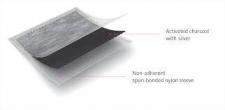The Continuum of Wound Dressings- Charcoal Dressings and Their Use in Managing Odor
Charcoal has been introduced into several classes of wound care dressings. Although charcoal in itself does not enhance wound healing, it can help to control odors associated with wounds, such as fungating and/or infected wounds. This is important, as wound malodor can be very upsetting for the patient: “Wound malodor is probably the most distressing symptom for patients and is caused by bacterial infection in devitalized tissue within the wound. This can also be devastating for the patient’s family and caregivers, as wound malodor may be constantly detectable and can trigger gagging and vomiting reflexes. The presence of a pervasive malodor can lead to embarrassment, disgust, depression and social isolation and may have a detrimental effect on sexual expression causing relationship problems” (World Wide Wounds, 2002).
What causes wound odor?
In short, it is the presence of bacteria that causes wound odor. “Malodorous wounds result from bacteria that reside in necrotic wound tissue. They are usually polymicrobic, containing both aerobic and anaerobic bacteria. For the most part, it is the anaerobic bacteria that emit putrescine and cadaverine, which result in foul odors; they can cause gagging and vomiting, and loss of appetite. Some aerobic bacteria such as Proteus and Klebsiella can also produce offensive odors” (O’Brien, 2012).
Thankfully, one can become almost immune to unpleasant odors when exposure is prolonged. Sensory cells can actually become desensitized to unpleasant odors, which may be why individuals living in close contact with an individual having a malodorous wound may seem to hardly notice an offensive odor (O’Brien, 2012).
How does charcoal reduce wound odor?
As mentioned, charcoal has been added to many dressing types to control odor. “When applied to a wound, the active charcoal layer absorbs bacteria and locally released toxins, as well as volatile amines and fatty acids responsible for wound odor” (Wounds International, 2012). Charcoal is often combined with an antimicrobial for odor management: “Bacteria thrive on wound exudate and moist devitalized tissue, which can cause wound odor. Infected wounds can show signs of malodor, exudate, and pain. Many products that are recommended to reduce odor also reduce bacteria levels” (Graves & Sun, 2013). Actisorb, combining charcoal with silver, is an example of a combination dressing designed to reduce wound odor by controlling bacteria.
Charcoal in wound dressings can effectively reduce wound odor, thus reducing potential patient distress and embarrassment. It is safe to use and may be combined with an antimicrobial to enhance odor control. If you have a patient with an infected or fungating wound that is malodorous, consider using a charcoal dressing to manage odor and ease your patient’s distress.
If you are enjoying this series on wound care products, you may consider becoming certified as a wound care professional. Wound Educators is the premier online wound education site, preparing professionals to become nationally certified. If you would like to learn more about becoming a certified wound care professional, please contact us.
Sources:
Naylor, W. (2002) Part 1: Symptom control in the management of fungating wounds. World Wide Wounds. Retrieved April 8, 2015 from http://www.worldwidewounds.com/2002/march/Naylor/Symptom-Control-Fungating-Wounds.html
O’Brien, C. (2012). Malignant wounds: Managing Odor. Canadian Family Physician, 58(3); pg. 272-274. http://www.cfp.ca/content/58/3/272.full
International case series: Using ACTISORB®: Case Studies. London: Wounds International, 2012. http://www.woundsinternational.com/media/issues/620/files/content_10586.pdf
Graves, M. & Sun, V. (2013). Providing quality wound care at the end of life. Journal of Hospice and Palliative Nursing; 15(2):66-74. http://www.medscape.com/viewarticle/780776_5


where can i get charcoal dressing if possible the tel no
Heather, try your search here – https://advancedtissue.com/2015/12/4-wound-care-products-that-combat-odor/
I have a yeast infection under my arms breast and between the folds of my stomach I also have a break out of pusular psorisis . Do you think it would be ok to use the charcoal pads to help with the burning and iching for a least under breast and arms….Please respond as soon as you can….Thanks in advance. Note; My email is no longer valid….Can you please respond here Thanks
Deborah –
I would recommend getting a second opinion if you have concerns. Without pictures or knowledge of treatment, we cannot properly judge symptoms, treatment, or outcomes. Hope this helps! You should contact a certified wound specialist to locate a wound center in your area. You can search for certified wound specialists in your area here: https://portal.abwmcertified.org/ABWMweb/Directory/ABWMcontent/Directory.aspx